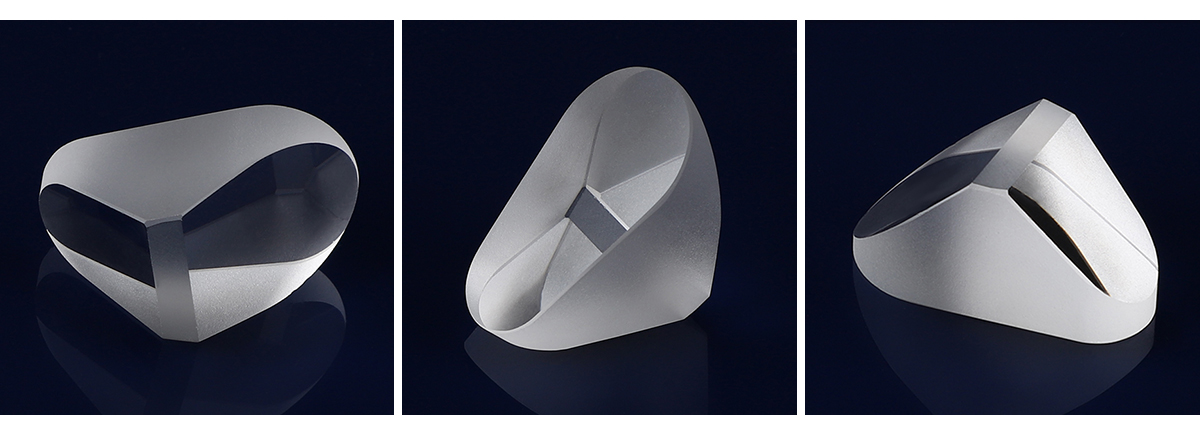The role of quartz prisms in optics
Quartz prisms have long played a crucial role in the field of optics and have been highly praised for their unique performance and versatility. These prisms are made of high-purity quartz and are essential in various optical applications, from basic light scattering to complex scientific instruments.

Understanding quartz and its optical properties
Quartz or silica (SiO2) is a natural mineral known for its excellent optical properties. It has high thermal stability, chemical inertness, and excellent ultraviolet (UV) transmittance, making it the preferred material in optical applications. The crystal structure of quartz ensures minimal light scattering and absorption, enabling it to transmit light across a wide spectrum from ultraviolet to infrared.
The refractive index of quartz is about 1.54, which is stable over a wide wavelength range, which is beneficial for producing precise optical components. In addition, quartz exhibits birefringence, which means it has different refractive indices along different crystal axes. This characteristic is used in various optical devices to control the polarization of light.
Types of quartz prisms
There are several forms of quartz prisms, each suitable for specific optical functions:
1. Equilateral prisms: These prisms have equal angles and are mainly used to scatter light into the spectral colors it forms. The equilateral quartz prism is the main component in spectroscopy, which decomposes light into spectral components for analysis.
2. Right angle prisms: These prisms are used to accurately reflect light at right angles. Their applications include beam control and image rotation. A right angle quartz prism is an indispensable part of laser systems and optical instruments, requiring precise alignment and reflection.
3. Dove Prisms: Named after Heinrich Wilhelm Dove, these prisms invert images without deviating from the light path. Quartz pigeon prisms are used for image processing and optical calculations, where orientation control is crucial.
4. Wedge prisms: These are used to deflect light beams at small angles. Quartz wedge prisms are used in laser beam control and optical alignment systems.

The application of quartz prisms in optics
The excellent optical quality of quartz prisms makes them indispensable in various fields:
1. Spectroscopy: In a spectrometer, an equilateral quartz prism disperses light into its spectral components. The wide transmission range and minimum absorption of quartz allow for precise and detailed spectral analysis in the ultraviolet, visible, and infrared regions.
2. Laser technology: Quartz prisms are essential in manipulating laser beams. A right angle prism redirects the beam with high precision, while a wedge prism adjusts the beam path. The stability and low coefficient of expansion of quartz ensure consistent performance even at different temperatures.
3. Polarization control: Due to birefringence, quartz prisms are used in devices such as polarizers and waveplates to control the polarization of light. These components are crucial in applications ranging from microscopes to telecommunications, where controlling the direction of the electric field of light is necessary.
4. Optical instruments: In telescopes, microscopes, and binoculars, quartz prisms can improve image quality and accuracy. For example, a Polo prism made of quartz is used in binoculars to provide correctly oriented and magnified images.
5. Lithography: In semiconductor manufacturing, quartz prisms help with the lithography process by focusing ultraviolet light and guiding it onto the silicon wafer. The high UV transmittance of quartz is crucial for forming complex patterns on semiconductor materials.
Progress and Innovation
The latest advances in optical technology further highlight the importance of quartz prisms. The innovation of photonic devices and quantum computing often relies on the precise optical operations provided by quartz prisms. In addition, femtosecond lasers require high-purity optical components. With the development of femtosecond lasers, quartz prisms are increasingly used for pulse shaping and beam control.
Another significant advancement is the use of quartz prisms in optical coherence tomography (OCT), a non-invasive imaging technique for medical diagnosis. The high clarity and stability of quartz prisms improve the resolution and accuracy of OCT systems, thereby enhancing diagnostic capabilities.
Quartz prisms are fundamental components in the field of optics, supporting a wide range of technologies and applications. Their unique characteristics, such as high transparency, thermal stability, and birefringence, make them universal tools for ranging from basic light scattering to advanced scientific instruments. With the continuous advancement of technology, the role of quartz prisms in optics may expand, driving further innovation and enhancing our understanding and manipulation of light. Jundro provides customized processing services for fused silica.
Dongguan Jundro ceramics Technology Co.,Ltd
E-mail:info@jundro.com
Tel:+86-769-82913501
Fax:+86-769-82913801
Add: Room 306, Gate B, Unit 1, Block 2 South, No. 1 Yile Road, Songshan Lake, Dongguan City, Guangdong Province, China(523808)
© August Dongguan Jundro ceramics Technology Co.,Ltd- 2023